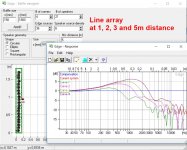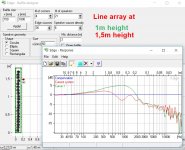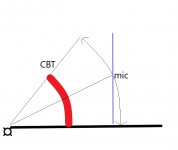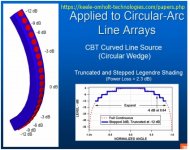A CBT has driver shading with delay(due to curvature). A straight array has shading but no delay. Don Keele has shown that a curved array thats not shaded is still a vast improvement over a shaded straight array ie the delay is more important than shading.
Now, the straight array has no arc, which means, if we keep narrowing the CBT coverage angle (arc angle) then it starts approaching a shaded straight array which we know is not constant directivity in the vertical. Does it mean that CBT performance breaks at very narrow angles lets say 5 degrees?
Thanks,
WA
Now, the straight array has no arc, which means, if we keep narrowing the CBT coverage angle (arc angle) then it starts approaching a shaded straight array which we know is not constant directivity in the vertical. Does it mean that CBT performance breaks at very narrow angles lets say 5 degrees?
Thanks,
WA
Last edited:
Do you mean horizontal or vertical offset?
I am not an expert with LA, but I keep wondering where the magic really lies. Power shading I cannot simulate, but delay is derivative of distance - a backwards curved array has extra delay between each driver compared to a straight line. An array is very sensitive to delay changes.
Listening distance in PA applications is large compared to domestic living rooms. In small rooms it also works in co-operation with floor and ceiling, making it virtually taller.
Here I simulate the effect of mic distance (listening distance) and height with a 1,,8m. The Edge simulates anechoid response and sadly it cannot show impulse response. Notice how summation/interference of sources changes when distance/delay interactions between drivers changes.
This behaviour is totally different from typical full range or multi-way with crossovers speakers! Would you accept up to 10dB changes in measured response in 500-2000Hz range at different spots? And how does that change affect power response in a small room? How would you equalize that?
I am not an expert with LA, but I keep wondering where the magic really lies. Power shading I cannot simulate, but delay is derivative of distance - a backwards curved array has extra delay between each driver compared to a straight line. An array is very sensitive to delay changes.
Listening distance in PA applications is large compared to domestic living rooms. In small rooms it also works in co-operation with floor and ceiling, making it virtually taller.
Here I simulate the effect of mic distance (listening distance) and height with a 1,,8m. The Edge simulates anechoid response and sadly it cannot show impulse response. Notice how summation/interference of sources changes when distance/delay interactions between drivers changes.
This behaviour is totally different from typical full range or multi-way with crossovers speakers! Would you accept up to 10dB changes in measured response in 500-2000Hz range at different spots? And how does that change affect power response in a small room? How would you equalize that?
Attachments
Last edited:
I mean that in CBT each driver is delayed and attenuated incrementally, the combination of these gives constant beam coverage at ALL reasonable distances. Vertically, it emulates a point source that is behind the array. The low corner of beam coverage is dictated by the height of the array but that is not the point.Do you mean horizontal or vertical offset?
What I am asking is that a
CBT with 0 curvature = a shaded array
CBT has constant directivity whereas shaded array does not. While we were reducing the angle of arc when did the CBT loose constant directivity?
Last edited:
^That (interverence between sources) is frequency -dependant, and still bit complex.
Curvature of LA affects time delay between sources. This interdriver delay stays constant only when mic remains at constant distance to the center of arch that the CBT has. If microphone is moved only straight up from the floor, inteferences and spl response changes because the distance to the centerpoint of arch increases.
When CBT curvature gets closer to straight line, response remains constant in a smalller group of points in space (narrower vertical window).
When mic position gets closer to the end of the arch (or equivalent of arch) , response changes because the cbt arch is no longer symmetrical, because of different length of arch up/down.
Have you read Keele's papers? They give lots of information, but I see also some things hidden and false simplifications of benefits, eg. this effect of measuring distance variation is skipped.
Curvature of LA affects time delay between sources. This interdriver delay stays constant only when mic remains at constant distance to the center of arch that the CBT has. If microphone is moved only straight up from the floor, inteferences and spl response changes because the distance to the centerpoint of arch increases.
When CBT curvature gets closer to straight line, response remains constant in a smalller group of points in space (narrower vertical window).
When mic position gets closer to the end of the arch (or equivalent of arch) , response changes because the cbt arch is no longer symmetrical, because of different length of arch up/down.
Have you read Keele's papers? They give lots of information, but I see also some things hidden and false simplifications of benefits, eg. this effect of measuring distance variation is skipped.
Attachments
Last edited:
There is a relation between line length, coverage angle and frequency above which the line exhibits constant directivity. Zero vertical coverage means that pattern control is kept down to a frequency of infinity, so there is no frequency range at which there is constant directivity.Now, the straight array has no arc, which means, if we keep narrowing the CBT coverage angle (arc angle) then it starts approaching a shaded straight array which we know is not constant directivity in the vertical.
I think this is explained by the following quote only being valid at frequencies above this 'cut off' frequency, as I think it cannot hold at low frequencies for which wavelength >> line length.
Keele said:Surface pressure distribution, nearfield pressure pattern, and farfield pressure pattern are all essentially the same! No nearfield!
Last edited:
Here Keele's papers etc. about CBT with power shading https://keele-omholt-technologies.com/papers.php
My previous simulations don't have this power shading, it is impossible to apply that in The Edge. It obviously attenuates the effect of interferences.
My previous simulations don't have this power shading, it is impossible to apply that in The Edge. It obviously attenuates the effect of interferences.
Attachments
Do you mean horizontal or vertical offset?
I am not an expert with LA, but I keep wondering where the magic really lies. Power shading I cannot simulate, but delay is derivative of distance - a backwards curved array has extra delay between each driver compared to a straight line. An array is very sensitive to delay changes.
Listening distance in PA applications is large compared to domestic living rooms. In small rooms it also works in co-operation with floor and ceiling, making it virtually taller.
Here I simulate the effect of mic distance (listening distance) and height with a 1,,8m. The Edge simulates anechoid response and sadly it cannot show impulse response. Notice how summation/interference of sources changes when distance/delay interactions between drivers changes.
This behaviour is totally different from typical full range or multi-way with crossovers speakers! Would you accept up to 10dB changes in measured response in 500-2000Hz range at different spots? And how does that change affect power response in a small room? How would you equalize that?
Were these sims from a straight unshaded array? If so it might be fun to look at ra7's measurements of such an array for a real world result:
https://www.diyaudio.com/forums/multi-way/284371-corner-floor-ceiling-line-array-using-vifa-tc9-13.html#post4584879
He tried varying distances as well as varying listening height with a straight unshaded full range floor to ceiling array.
Do you mean horizontal or vertical offset?
I am not an expert with LA, but I keep wondering where the magic really lies. Power shading I cannot simulate, but delay is derivative of distance - a backwards curved array has extra delay between each driver compared to a straight line. An array is very sensitive to delay changes.
Listening distance in PA applications is large compared to domestic living rooms. In small rooms it also works in co-operation with floor and ceiling, making it virtually taller.
Here I simulate the effect of mic distance (listening distance) and height with a 1,,8m. The Edge simulates anechoid response and sadly it cannot show impulse response. Notice how summation/interference of sources changes when distance/delay interactions between drivers changes.
This behaviour is totally different from typical full range or multi-way with crossovers speakers! Would you accept up to 10dB changes in measured response in 500-2000Hz range at different spots? And how does that change affect power response in a small room? How would you equalize that?
The CBT is very consistent when distance is varied or even measurement height is varied. Pls see Don's measurements at page 99 and 100
http://www.linkwitzlab.com/Keele - Introduction to CBT Loudspeaker Arrays.pdf
But thats not the point.
Take a constant height CBT 45 arc array lets say 1M, now its low pattern control corner frequency is fixed ~ 345Hz. Its beamwidth is ~30 degrees ( 65% of arc angle).There is a relation between line length, coverage angle and frequency above which the line exhibits constant directivity. Zero vertical coverage means that pattern control is kept down to a frequency of infinity, so there is no frequency range at which there is constant directivity.
I think this is explained by the following quote only being valid at frequencies above this 'cut off' frequency, as I think it cannot hold at low frequencies for which wavelength >> line length.
Now keep height same, 1 M, but make arc 15 degrees. The array now provides beamwidth of 9.75.
If we keep reducing the arc angle to 0, it becomes a shaded array. In other words, isnt a shaded array a special case of CBT array? And we do know that a shaded straight array is not a broadband constant directvity device.
- Status
- This old topic is closed. If you want to reopen this topic, contact a moderator using the "Report Post" button.
- Home
- Loudspeakers
- Full Range
- Does CBT theory break at narrow coverage angles?



